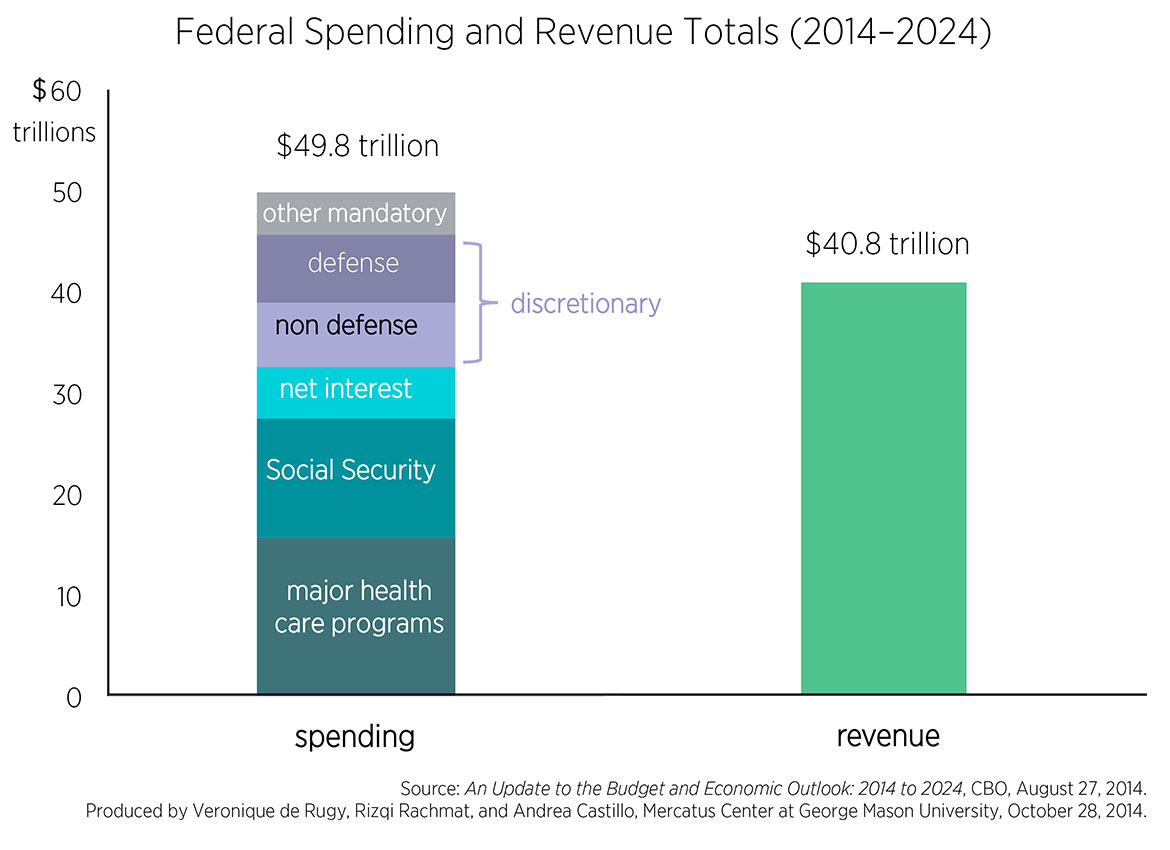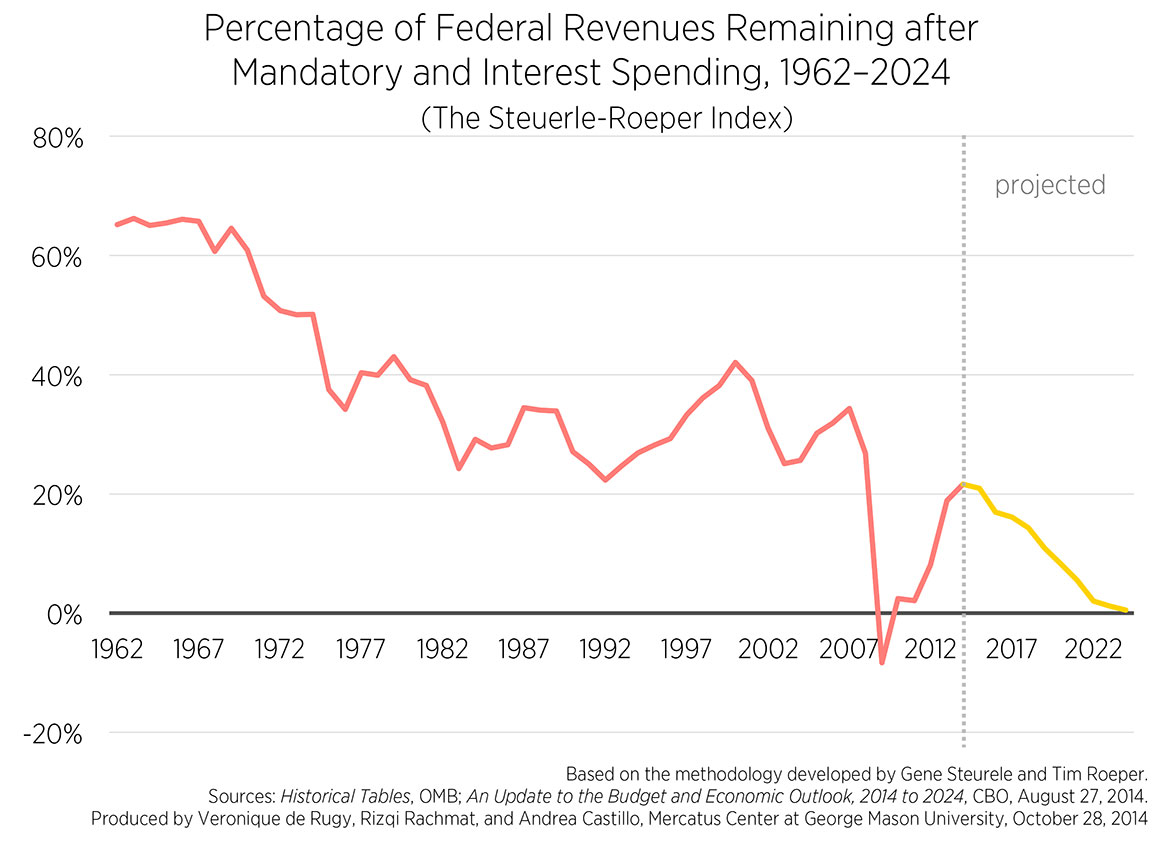- | Government Spending Government Spending
- | Data Visualizations Data Visualizations
- |
Frightening Federal Budget Trends
This week’s charts use data from CBO and the Office of Management and Budget’s (OMB) historical tables to display cumulative federal spending and revenues projected over the next decade along with a time series plotting of the Steuerle-Roeper Index of Fiscal Democracy, developed by Eugene Steuerle and Tim Roeper, which measures the percentage of federal revenues remaining for discretionary spending after mandatory outlays and interest payments have been covered.
The ghosts of federal spending past are here to haunt our nation’s fiscal future. This Halloween, the most terrifying frights won’t be found in the creepy mansion on the edge of your town; they’ll be found in the Congressional Budget Office’s (CBO) Update to the Budget and Economic Outlook. Ten-year federal outlays exceed projected revenues by $9 trillion and growing mandatory and entitlement obligations represent by far the biggest items in our budget especially compared to discretionary spending ones such as veterans’ services, transportation, and national defense. The charts show that without fundamental entitlement reform, the future of federal budgeting will be spooky, indeed.
This week’s charts use data from CBO and the Office of Management and Budget’s (OMB) historical tables to display cumulative federal spending and revenues projected over the next decade along with a time series plotting of the Steuerle-Roeper Index of Fiscal Democracy, developed by Eugene Steuerle and Tim Roeper, which measures the percentage of federal revenues remaining for discretionary spending after mandatory outlays and interest payments have been covered.
The first chart displays CBO’s cumulative baseline projections for federal outlays and revenues over the next ten years in trillions of real 2013 dollars. While CBO anticipates the federal government will rake in $40.8 trillion in revenues from 2014 to 2024, projected spending of $48.9 trillion over that same time will result in a gap of $9 trillion. The spending column on the chart breaks down the composition of federal outlays. Expenditures on major health care programs—such as Medicare, Medicaid, the Children’s Health Insurance Program (CHIP), and new health care subsidies enacted under the Affordable Care Act—are projected to amount to $15.7 trillion. Social Security comprises another $11.8 trillion. Remaining mandatory spending—on programs such as the Supplemental Nutrition Assistance Program (SNAP, commonly referred to as “food stamps”), unemployment compensation, and veterans’ benefits—is projected at $4.2 trillion. Interest payments on the debt are expected to cost roughly $5.1 trillion. These items alone tally to an astounding $36.8 trillion of the $49.8 trillion in total ten-year federal outlays, or 74 percent of the total. This leaves roughly $13.1 trillion remaining for all discretionary spending, $6.7 trillion of which is dedicated to defense spending and $6.3 trillion of which remains for spending on items like transportation and scientific research.
The second chart displays this budgetary trade-off between mandatory spending along with interest payments on the debt and discretionary spending from 1962 through 2024 projections. The Steuerle-Roeper Index is calculated by subtracting mandatory and interest spending from total federal revenues and dividing the difference by total revenues. In other words, the index measures how much revenue is left to cover all other budget items once mandatory spending and interest payments have been made. A high percentage means that there are ample funds remaining for other budget items. A low percentage suggests that few federal funds remain for discretionary spending.
As the chart shows, the Steuerle-Roeper index declines over the next decade, indicating dwindling federal funds for discretionary spending. The average measure for 2003 through 2024 is about 14 percent—about one third the average value of the index for the years 1962 through 2002 of 41.5 percent. The average measure for the next decade drops to just over ten percent. By 2024, the Steuerle-Roeper measure of 0.5 percenta level below the 2.4 percent and 2 percent the index reached in the aftermath of the Great Recession.
If left untouched, the federal budget could one day become merely a transfer mechanism for entitlement programs and a debt machine that incurs higher and higher interest payments, so discretionary programs of the sort Americans are accustomed to will be harder to continue. While this year’s Halloween frights will soon fade, this budget problem will continue haunting our future unless we start fixing it now.
Note: discretionary spending is projected to grow in nominal terms. Its budget share is shrinking.




